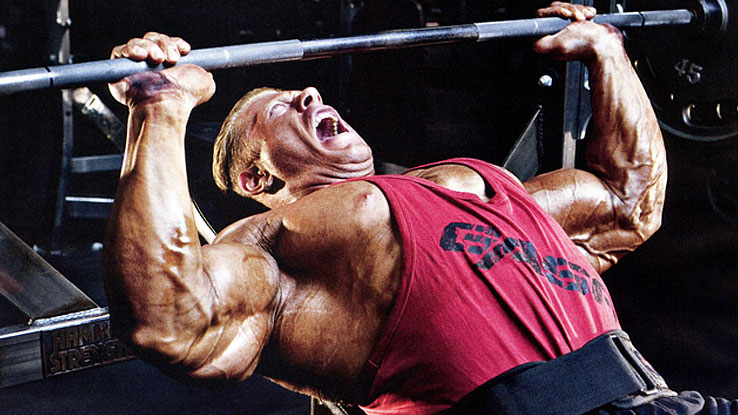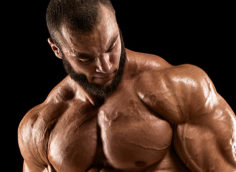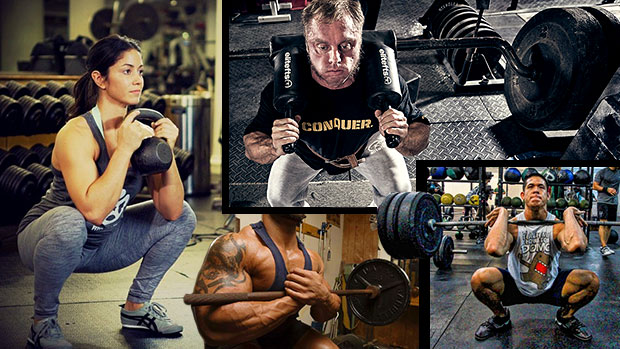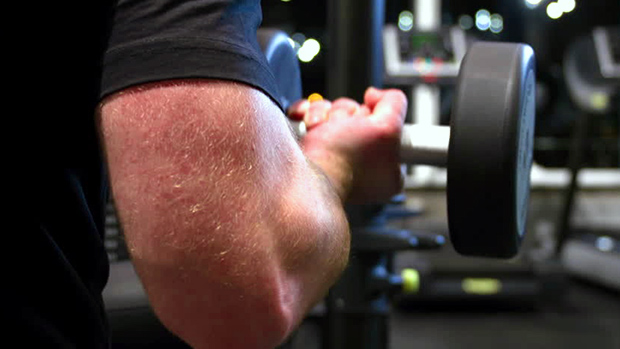The weight room isn't kind to tall guys. Lifting weights requires a lot more energy, coordination, and actual time for each set when your height is a factor. To make a bad story worse, long muscle bellies make it difficult to pack on muscle volume, so even a significant weight gain can translate to a sub-par size gain.
Here's the deal: tall guys must remember that when it's strictly size we're interested in, we have to look at things in reverse. Lifters who want to build strength are constantly looking for ways to refine their technique so they have optimum leverage over the weights. If you're tall like me, though, and your goal is to exhaust the muscles for all they're worth to make them grow, shouldn't you be searching for the best ways for the weights to have leverage over you?
With that in mind, here are my favorite tips and exercises (based on anecdote and science) for tall guys to use when bulking up. These movements don't have to supplant the big three, but they can be used during a training phase to build size and smash plateaus.
To build size we need to take advantage of the mechanical "disadvantage" that we have as longer-limbed creatures. The amount of additional time, space, and force it takes for us to perform an exercise like a chest fly, reverse fly, or lateral raise can mean more potential muscle.
The lever arm created by a weight held much farther away from the torso will be larger than that of a short-armed individual, so it makes sense to train these movements. As such, cable variations of chest flies work well due to the constant tension.
The pin press allows a bench presser to lift heavy with less pain as the bar is starting on pins set a few inches above chest level. Performing cluster reps with the pin press is great for long-armed dudes since the elbows don't have to travel quite as far below the level of the bench, meaning less shoulder stress at the bottom of the lift.
Furthermore, the pin press gives you an opportunity to practice concentric-only training – you can drop the bar back down to the pins from the top position with minimal tension. This increases the amount of max efforts you can do since the eccentric phase is typically the most taxing on the CNS.
Lunges and split squats make the quads and glutes do plenty of work. These movements are superior to the leg press as most leg press machines aren't designed to accommodate a tall lifter's frame.
If you're over 6-foot 4, the leg press doesn't work well for you unless you have superior ankle mobility. In lieu of that, you need to assume a very high foot position on the platform.
Front squats hit the quads more in a typical trainee due to changes in body geometry through the lift. In the case of a tall guy with ultra-long femurs, however, it again comes down to ankle mobility. Someone of average ankle mobility may have depth issues during a front (or back) squat as their knees can't track forward enough to facilitate increased squat depth, at least not without their heels leaving the floor.
Apart from doing daily dorsiflexion exercises and ankle mobility drills to improve this, try elevating the heels slightly. Remember, the more you can get your knees to track over your toes, the more quad-dominant the lift becomes. Insufficient ankle mobility typically leads to a more vertical shin angle when squatting and lunging, which encourages more glute and hamstring contribution.
I recommend front squatting over back squatting because poor ankle mobility, long femurs, and a bar loaded on the back is a recipe for a squat that resembles a good morning. A front load can encourage a vertical torso position, which will help tall guys get the most out of their squat.
The leg extension and leg curl machines get a lot of hate. They create shear forces on the knees that can wreak havoc, specifically if you have muscle imbalances and/or a history of knee problems. That said, if you're a tall lifter and you don't fall into this category, then have at them!
They're effective because of the leverage disadvantage mentioned earlier. The huge lever arm created by the distance between the fulcrum and resistance (in this case, the knee joint and shin pad) means more time under tension, more lactate production, and more distance travelled. That translates to serious growth of long muscle bellies of the quads and hamstrings.
Chicken wing shoulder blades and undeveloped back muscles are common amongst tall guys. The back is our cornerstone and those muscles contribute significantly to maintaining proper posture. Therefore, hammering away at the upper and mid back is important if we want to look large and imposing and feel healthy.
It doesn't always take the heaviest loads to get the job done, either. High-rep training is great for adding size to the back, and the cumulative volume also makes the arms blow up.
Chin-ups are the best upper body movement to master and the best way to add size to the biceps. Using a narrower palms-in grip is the key to targeting the brachialis muscle, which is responsible for the coveted "peak" we see in developed arms.
Isometric tension held in the lats through wide-grip pulls is another solid way to hit the endurance-geared fibers of the back (which there are plenty of) through increased time under tension. Furthermore, snatch grip rack pulls, trap-bar deadlifts, and Dead Squats are great deadlift alternatives if finding a comfortable traditional deadlift starting position is a chore.
A very short torso coupled with long legs makes it difficult to use a conventional deadlift set-up since it's hard to position the shoulder blades above the bar, which is the ideal position. The lowered pulling space in a snatch-grip rack pull, along with the ability to lower the hips in a trap-bar deadlift, are both money makers that can keep your pulling strength in check.

This wouldn't be complete without a sample program, so here it is:
The Best Damn Tall Guy Program, Period
Day 1 – Back
| Exercise | Sets | Reps | Rest | |
|---|---|---|---|---|
| A | Snatch Grip Rack Pull | 6 | 6 | 3 min. |
| B | Trap-Bar Deadlift | 5 | 8 | 2-3 min. |
| C | Chin-Up | 5 | max | * |
| D1 | Bent Over Dumbbell Fly | 4 | 15 | |
| D2 | Face Pull | 4 | 15 | 90 sec. |
| E | Seated Row | 5 | 12-15 | * |
* as long as needed
Day 2 – Chest
| Exercise | Sets | Reps | Rest | |
|---|---|---|---|---|
| A | Flat Pin Press | 6 | 4-rep cluster | 3 min. |
| Set the pins 2-3 inches above chest level. Cluster sets mean that you perform each rep as a "mini-set" and rest about 5 seconds between each rep (enough time to rack the bar and re-set) for a total of 4 reps. | ||||
| B | Low Incline Dumbbell Bench Press | 5 | 10 | 3 min. |
| Aim for a good pump by not fully locking out at the top of each rep. | ||||
| C | Standing Cable Chest Fly | 4 | 15 | 2 min. |
| Set the pulleys up high and perform the fly pattern from "high to low." | ||||
| D | Push-Up | 2 | to failure | * |
* as long as needed
Day 3 – Legs
| Exercise | Sets | Reps | Rest | |
|---|---|---|---|---|
| A | Front Squat | 6 | 8 | 2 min. |
| B1 | Reverse Lunge from Deficit (See video below) | 4 | 10 / leg | |
| B2 | Leg Extension | 4 | ladder * | 3 min. |
| C | Romanian Deadlift | 4 | 10 | * * |
| D1 | Eccentric Glute-Ham Raise | 3 | 6 | |
| D2 | Hamstring Curl | 3 | ladder * | 3 min. |
* Perform 2, 3, 5, and 10 reps with the same weight, resting 10 seconds between each group of reps.
* * as long as needed
Day 4 – Shoulders
| Exercise | Sets | Reps | Rest | |
|---|---|---|---|---|
| A | Standing Press | 5 | 10 | 2-3 min. |
| B1 | High Pull | 5 | 8 | |
| B2 | Dumbbell Standing Lateral Raise | 5 | 12 | 2 min. |
| C | Seated Dumbbell Neutral Grip Press | 4 | ladder * | 3 min. |
| D | Wide Grip Bent Over Row | 4 | 10-12 | 2-3 min. |
| Use a grip significantly wider than your typical bench press grip. Keep the elbows flared out to hit the rear deltoids. | ||||
* Perform 2, 3, 5, and 10 reps with the same weight, resting 10 seconds between each group of reps.
No one is ever going to convince me that it sucks to be tall. I can dunk a basketball, fill out a suit, and I never stress about not being tall enough to get on all the rides at the amusement park.
Still, there are real challenges when it comes to building muscle, so rather than bang your head against the squat rack or stress about stuff you can't change, start using your long levers to your advantage.





